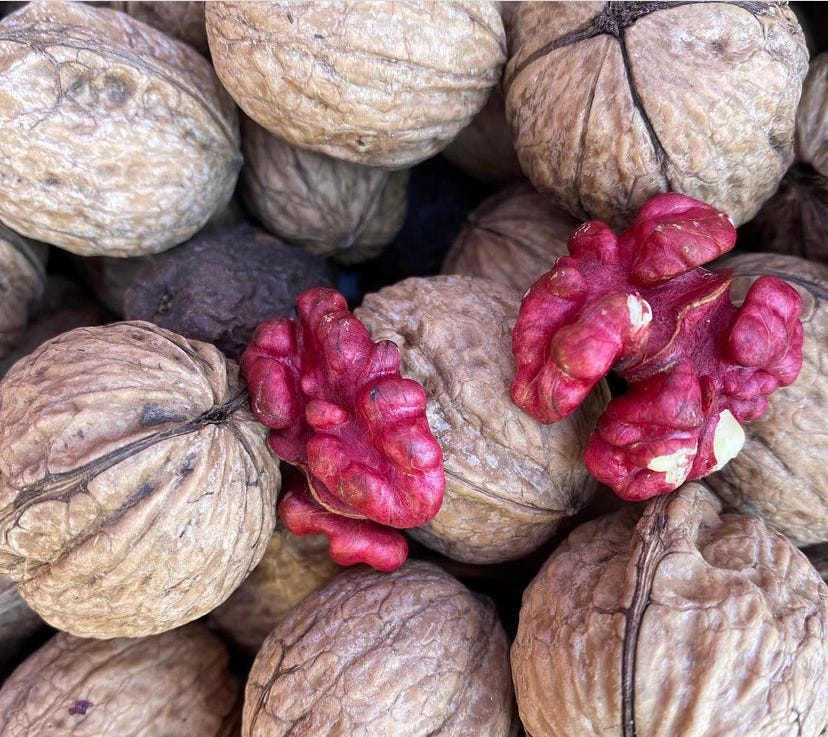Gjelina Group Goes to the Market: Red Walnut
“It’s genetic engineering done by mother nature.”
By Grace Geller
I am always so interested when I hear of “new” produce and plants. For some reason, I imagine fruits, vegetables and nuts as these beings that have existed forever and have their own unique and independent life cycles and evolutions over thousands of years. But creating a brand new plant? Theoretically, I know it is not uncommon and still, I find it amazing every time. One of my latest learnings and a delicious star on the GTA and Gjelina menu is the red walnut.
The story of the red walnut starts in 1991 at University of California, Davis. A cultivar of the Purpurea walnut (a variety of Persian red skinned walnut) was given to the university from the French National Institute of Agricultural Research. This cultivar was grafted onto a Howard walnut (a variety of English walnut tree) and the red walnut was born!
Grafting is a horticultural process that has some theoretical similarities to genetic modification, which you may be more familiar with. Genetically modified foods are, as the name suggests, foods that have had their DNA modified in a way that does not happen naturally. Grafting is a bit different. Grafting is a technique that creates the container for gene swapping to occur. So by definition, there is a difference. However, genetically altered plants can be a result of grafting!
Raph Block of the Max Planck Institute of Molecular Plant Physiology in Potsdam, Germany says, “It’s genetic engineering done by mother nature.” Personally, I like to think of grafting sort of like an arranged marriage between trees, but then again, I am a romantic.

Grafting is the process of fusing two trees into one fruiting body. The lower of the two trees is called the rootstock and makes up the foundation of the tree, the roots and connection to earth. In the case of the red walnut, the rootstock is the Howard English walnut which is a great choice for a base. The Howard is a small but mighty plant. It can thrive in high density plantings and is known for being prolific, producing reliable, large and creamy fruits which are easier to harvest due to the tree’s shorter height. The other part of the graft is called the scion and directs the fruiting behavior of the tree including flavor and color. The red walnut’s scion is the Purpurea walnut also known as the purple leaved walnut. This is a rare, slow growing form of the common walnut with stunning red husks. This is why the red walnut has its beautiful red hue. To form a graft union, cuts are made into the rootstock and scion, exposing the cambium of the tree (the living inside). Then these trees are bonded together and as both trees send signals to repair their wounds, they secure themselves together forming a union which can go on to produce an entirely unique fruit!
Ok, that's enough tree talk. Now onto the fruit of all this labor. The red walnut is an ultra creamy variety that has a more oily taste with less tannins compared to other walnuts. The nut has to be processed by hand instead of mechanically or else the delicate red skin is easily compromised. The product has so much human care and attention put into it and it clearly shows. To me, the red walnut tastes like the best-of-both-worlds scenario of its two parents. The creamy, nuttiness of the English walnut and the bold, striking visuals of the Purpurea. We are currently using the red walnut from K&K Ranch based in Orosi, CA at Gjelina in the red walnut gelato and red walnut tart which is our take on something like a pecan pie. At GTA, we are taking a savory approach, featuring it in the quinoa salad alongside some of our favorite produce stars of springtime. You can’t go wrong with any of them and we encourage you to to come in and try this beautiful child of horticultural innovation!





Coolio!